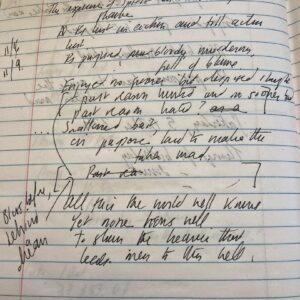In the boundless months of Covid’s unruly spread, I want rules that will establish the illusion of safety. Give me a task, clear directions, a tidy end. When the May issue of Poetry dropped through my mail slot, it landed so I got to read the back cover first, lines from classicist/poet A.E. Stallings’s “Daedal”: “To build a labyrinth it takes / some good intentions, some mistakes.” Perfect, with allowances for the imperfect. These lines introduce meter, rhyme, and the suggestion of a controlled environment from the safely distant past. I’d been given my task, to build a labyrinth—as if the virus hadn’t already managed to lock us into one.
DAEDAL
To build a labyrinth it takes A twisted mind, a puzzled art, A fractal branching of mistakes. Drag out the shovels and the rakes, The spirit level, sacred chart To build a labyrinth it takes Shadows, stones, a way that snakes And ladders to its shaky start; An average mazing of mistakes, The kind that everybody makes, Set random intervals apart. To build a labyrinth it takes Dead ends that seem like lucky breaks, The paths of bats that weave and dart Through limestone caverns of mistakes. The shaken Etch A Sketch awakes A lost child buried in its heart. To build a labyrinth it takes Some good intentions, some mistakes.
Despite the final stanza’s mention of a modern toy, the sixteenth century word that serves as title seems outside of time. Stallings lives in the country that gave us the designer of the most famous labyrinth, Daedalus, from whose name comes the title; “daedal” is an English adjective meaning “finely wrought.”
And this poem uses an intricate conventional form. The villanelle began in Italy as a peasant song, was imported to France and gentrified, taken to England and further tailored. It’s nineteen lines in five tercets and a quatrain, repeating words, phrases, whole lines, and using only two rhymes. Stallings cinched it tighter by choosing iambic tetrameter. Nothing is left to chance. Although we read “dead ends that seem like lucky breaks,” in fact, a labyrinth, unlike a maze, traditionally formulates the way in to be also the way out, embedded in itself, with only one threshold.
Ultimately, there are no dead ends.
Our lives appear designed mostly in retrospect. Tensions are always present in “the fractal branching of mistakes.” Revise. Try “the spirit level, the sacred chart,” and still the result is “an average mazing of mistakes, the kind that everybody makes.” In fact, the whole finely wrought poem, so reassuring in its technique, ends on the word that’s been there from the start and it won’t escape: “mistakes.”
Stallings alludes to a game called “Snakes and Ladders.” Americans know it as “Chutes and Ladders.” By turning the nouns into verbs, the poem makes clever use of the game’s original name. Brought from India by the British, it’s played on a grid of 100 squares. Moves rely on karma and kama, destiny and desire, simplified. The object is to advance a piece at the roll of a die from the bottom square to the top, helped by virtue (climbing ladders), hindered by vice (falling snakes). It’s the origin of our saying “go back to square one.”
The form makes the content, the labyrinthine instructions, memorable. Maybe that too drew me to the poem. I hadn’t memorized anything since childhood, a Catholic schoolgirl tested daily on the Baltimore catechism for the sake of eternity.
But now, for sanity’s sake in this life, I could try memorizing poetry. In the July 29, 2020 issue of The Atlantic, contributor Eliot A. Cohen writes in his article, “Go Memorize a Poem,” “In times of crisis, learning and reciting poetry can act as a balm.” Strangely enough, repetition in the villanelle’s pattern charged me out of my numbed-down daily life. Obsessive repetition, especially aloud, can cause us to feel both static and ecstatic. We learn it—we say because it’s true—by heart.
Rhyme is a method of composition. This is a tightly rhymed poem about composition. It is also about composure. “Some good intentions, some mistakes” is a generous invitation to embrace complexity inside the repeated sounds.
Repetition in the poem is also an aspect of its subject. As in life, mistakes are “set random intervals apart,” just enough so one has forgotten an earlier reliable predictability. The intervals seem random until one regards, detached, the pattern in the form. The mention of erratic flights of bats in enormous “caverns of mistakes” is surprising. And then comes the envoi, the final stanza, four lines instead of the usual three. Different, but formally not a mistake.
Even more jarring is the introduction of a twentieth century toy, the “shaken Etch A Sketch,” a risk in the timelessness of the poem. Could I make that jump? To design and not erase by chance, it takes skill to create structures, schemes, maps. Architectural blueprints are two-dimensional. It troubled me, in fact; now I’m not only stuck with modernity but implicated by a third dimension: “a lost child buried in” the heart of it.
In Archaic Smile (1999), her first book, Stallings gave us “Tour of the Labyrinth,” a chilling reminder of why the structure was made in the first place. The adults hid their monster, made excuses for the sounds below the stair, the quake, the falling bricks. Unearthed later by archeologists, an unidentifiable skeleton was found and with it, its only toy, a ball of string.
In “Daedal,” it’s not even a particular child; the indefinite article holds this child awakened at a distance, vague. Is it an oblique sympathetic reference to the Minotaur? Is it Icarus, the lost son of the original designer, Daedalus? Is it I who shook the Etch A Sketch, another of the mistakes hinted at? The toy with its two knobs is small enough to hold in my lap. Shaken, the screen goes blank as a blanket under which is buried a lost child. Awake now to my own good intentions, my mistakes. The randomness of the falling snakes, the toss of a die.
The poem is a blueprint for our aspirations, balanced by fleshed-out experience. It offers guidance for a daedal life, opening and closing with the same assurance of mistakes. That kind of timeless balm.
Jeanine Hathaway is the author of the novel, Motherhouse, the 2001Vassar Miller Poetry Prize-winning The Self as Constellation, the chapbook, The Ex-Nun Poems, and Long after Lauds which won a 2020 Catholic Book Award for Poetr





